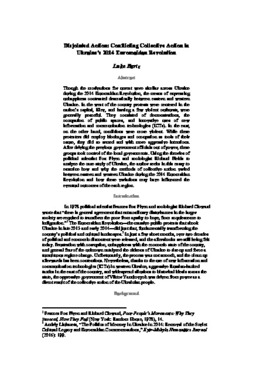| dc.creator | Bartz, Luke | |
| dc.date.accessioned | 2018-02-14T22:22:17Z | |
| dc.date.accessioned | 2021-04-14T14:32:44Z | |
| dc.date.available | 2018-02-14T22:22:17Z | |
| dc.date.available | 2021-04-14T14:32:44Z | |
| dc.date.issued | 2017 | |
| dc.identifier.uri | https://hdl.handle.net/11244.46/1396 | |
| dc.description | © 2017, The Journal of Global Affairs is the official student research publication of the Department of International and Area Studies in the College of International Studies at the University of Oklahoma. Correspondence may be sent to: Journal of Global Affairs, C/O CIS/DIAS, 729 Elm Avenue, Hester Hall 150, Norman, Oklahoma 73019, United States of America. Email: jga@ou.edu. | |
| dc.description.abstract | Though the motivations for unrest were similar across Ukraine during the 2014 Euromaidan Revolution, the means of expressing unhappiness contrasted dramatically between eastern and western Ukraine. In the west of the country protests were centered in the nation's capital, Kiev, and barring a few violent outbursts, were generally peaceful. They consisted of demonstrations, the occupation of public spaces, and innovative uses of new information and communication technologies (ICTs). In the east, on the other hand, conditions were more violent. While these protesters did employ blockages and occupation as tools of their cause, they did so armed and with more aggressive intentions. After driving the previous government officials out of power, these groups took control of the local governments. Using the theories of political scientist Fox Piven and sociologist Richard Fields to analyze the case study of Ukraine, the author seeks in this essay to examine how and why the methods of collective action varied between eastern and western Ukraine during the 2014 Euromaidan Revolution and how these variations may have influenced the eventual outcomes of the each region. | |
| dc.description.abstract | About Luke Bartz | |
| dc.description.abstract | Graduating with a Master of Arts in Global Security Studies, a Bachelor of Arts in International Studies, and a Bachelor of Arts in Russian, Luke Bartz has focused his research on international security and the Russian- speaking world with special emphases on Kazakhstan and Ukraine. Thanks to the support of the College of International Studies and a number of other organizations, he has studied and worked abroad in Russia, Kazakhstan, Turkey, the Dominican Republic, South Korea, Austria, and China. After graduation he intends to pursue work with a human-rights-focused international organization or with the US Department of State's Foreign Service. | |
| dc.description.sponsorship | The Journal of Global Affairs is published in conjunction with the College of International Studies at the University of Oklahoma. | |
| dc.format.extent | 10 pages | |
| dc.format.extent | 199,106 bytes | |
| dc.format.medium | application.pdf | |
| dc.language | en | |
| dc.relation.ispartofseries | Journal of Global Affairs ; 6 (January 2017) | |
| dc.relation.requires | Adobe Acrobat Reader | |
| dc.rights | Attribution 4.0 International (CC BY 4.0) | |
| dc.rights.uri | https://creativecommons.org/licenses/by/4.0/ | |
| dc.title | Disjointed Action: Conflicting Collective Action in Ukraine's 2014 Euromaidan Revolution | |
| dc.type | document | |
| dc.type | text | |
| dc.type | image | |
| dc.contributor.sponsor | University of Oklahoma. College of International Studies | |
| dc.description.undergraduate | undergraduate | |

